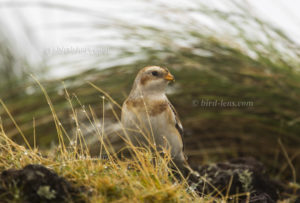 The Snow Bunting (Plectrophenax nivalis) is one of the few migratory passerines to be found on a regular basis to visit the Azores archipelago in general and Flores in particular. Maybe only the Northern Wheatear (Oenanthe oenanthe) of the subspecies leucorhoa, the Greenland Wheatear is recorded as often on Flores, the westernmost island of the archipelago.
The Snow Bunting (Plectrophenax nivalis) is one of the few migratory passerines to be found on a regular basis to visit the Azores archipelago in general and Flores in particular. Maybe only the Northern Wheatear (Oenanthe oenanthe) of the subspecies leucorhoa, the Greenland Wheatear is recorded as often on Flores, the westernmost island of the archipelago.
The morning of the 11th of October 2017 turned to be sunny, but started quite cloudy and in the higher parts of the inner plateau with fog with visibility that was only 10 meters. On return to the northern coast I decided to pay the highest peak of Flores, the Morro Alto, a short visit. Still, at 10:00 moist atlantic air clouded the Pico da Sé. Wind was blowing and one little bird, brightly colored in a creamy yellow and some dominance of white in the wing plumage jumped over the volcanic gravel around the antennas erected on the peak. It was a non-breeding plumage Snow Bunting, which the Portugese name Escrevedeira-das-neves. A non-inviting place to rest. Drops of water hang on the grasses. There was nothing obvious to feed on but the Snow Bunting inspected everything with emphatic patience.
Morro Alto is the highest point on Flores Island with 914m (asl). The Pico da Sé is the top, forming an imposing volcanic rock embedded between two deep valleys of erosion, the Ribeira do Badanela and Fazenda. The shallow lake Lagoa Branca shines like a blue, green and yellow jewel on the bottom of the valley.
The moist atlantic climate functions as an ecological modeler. The moist air gives rise to the “fog zone” with very strong winds and high rainfall, promoting the emergence of bogs (Sphagnum spp.), only sparsely vegetated by Azores juniper (Juniperus brevifolia) a species of juniper, endemic to the Azores where it occurs at altitudes of 240-800 m. This high zone has a peculiar and distinct touch to the rest of the island. Good possible that this vegetation is a welcome reminiscence of its tundra home ground.
The male, the female and the young birds behave like typical buntings. Morphologically they might resemble a crouching female House Sparrow (Passer domesticus), being however slightly larger and having a lighter plumage than this common bird on the island. There are other obvious differences, such as the color of the beak which differentiate the bird immediately. The adult males in breeding-plumage are easily identified by the dominance of white in their plumage.
The species is of a holartic, this means circumpolar Arctic, origin. It is an Arctic specialist and the snow bunting is the most northerly recorded passerine in the world. There are small isolated populations on a few high mountain tops south of the Arctic region, including the Cairngorms in central Scotland. This means, that we do not know, whether it migrating from breeding grounds in Europe or North America. On the Azores the bird is usually present from the beginning of October until the beginning of April.
There are observations of this species on all the islands of the archipelago, sometimes of dozens of birds. In general they show a preference for the highest zones, above 800 meters of altitude. But there are records of birds in low numbers down to the level of the sea.
Flores in general has a great potential for birdwatching, especially for American migratory birds, including passerines of several habitats. Habitats include lagoons, streams, woods, coastal areas, small pastures and agricultural fields. This wide variety of habitats allows the observation of an interesting range of resident and migratory birds.
But Flores is convincing not only birding-wise. A few minutes from e.g. the small village of Fajã Grande there are several natural swimming pools, bathing facilities under the waterfalls, two restaurants and a few small pubs, a balneario with a children’s swimming pool and shower facilities. And in the evening you can enjoy the “westernmost sunset of Europe” over the Atlantic …
In order to satisfy the growing demand for top shots of the rarer species of Western Palearctic, Bird-lens.com has undertaken dedicated trips to nearby and distant bird areas. This is to be able to do anything to provide excellent images of the birds of the Western Palearctic. Sometimes the yield of images is enriched by bird species, which are very unlikely to show-up in the Western Palearctic. The results in images even of rare Western Palearctic birds are very good. The beautiful image of the blog is only a first impression of what you will find in behind “Picture Shop” very soon. Simply contact bird-lens.com if you need an image of a bird before the newest images are online.